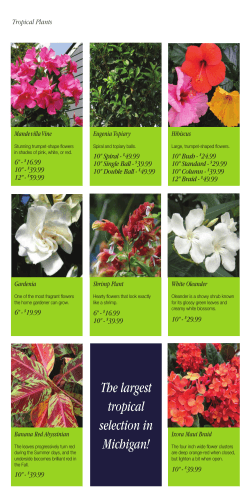
family Fabaceae draft 1
CATNIP classes, Acme Botanical Services 2013 Fabaceae (Pea Family, Bean Family, Legume Family) The third largest family of angiosperms (behind the aster family (Asteraceae) and the orchid family (Orchidaceae), the Fabaceae includes somewhere between 16.000 and 20,000 species. It rivals the grass family (Poaceae) in terms of economic importance. The Fabaceae includes plants of all growth forms, from trees and shrubs down to annual and perennial herbs. Members are easy to recognize on the basis of the foliage, which involves compound leaves of various kinds; the flowers, which are of three types (see subfamilies below); and the fruit, which is a single-chambered dry pod. Three subfamilies are recognized. All three are well represented in the Capital area. Mimosoideae. In this subfamily, the leaves are twice-pinnately compound. The flowers are tightly packed into heads or spikes. The flowers are regular (radially symmetrical), but the perianth (corolla and calyx) is so tiny as to be scarcely noticeable. The stamens are the conspicuous part of the flower, usually numerous and 10 times or more as long as the corolla. In many species, such as Nuttall’s sensitivebriar (Mimosa nuttallii, right), the flower heads resemble pink pom-poms. Caesalpinoideae. Plants of this group have even-pinnate or odd-pinnate leaves. The flowers have a conspicuous corolla with 5 separate petals. The stamens are separate and visible (i.e., not concealed by the corolla. Most of the species in our area have yellow petals. Roemer’s two-leaf senna (Senna roemeriana, right) is typical. Papilionideae. This is the largest subfamily in our area, and the one with the bilaterally symmetrical two-lipped flowers that come to mind any time the pea family is mentioned. In these flowers, the upper lip is formed by a single petal called the banner, while the lower lip includes two petals that are fused into a keel and two flanking petals called the wings. The 10 stamens are not exerted; they are usually tucked into the trough formed by the fused keel petals. Typically, nine of them are usually united for most of their length while the tenth is free. In Lindheimer’s tephrosia (Tephrosia lindheimeri, below left), a sandyland endemic, the banner is broad and erect; the wings are well developed and conceal the keel. The leaves are pinnately compound, but in the Papilionoideae as a group many other leaf arrangements are also common. Papilionoid flower. Source: Wayne’s Word, at http://waynesword.palomar.edu/termfl2.htm
© Copyright 2025




















